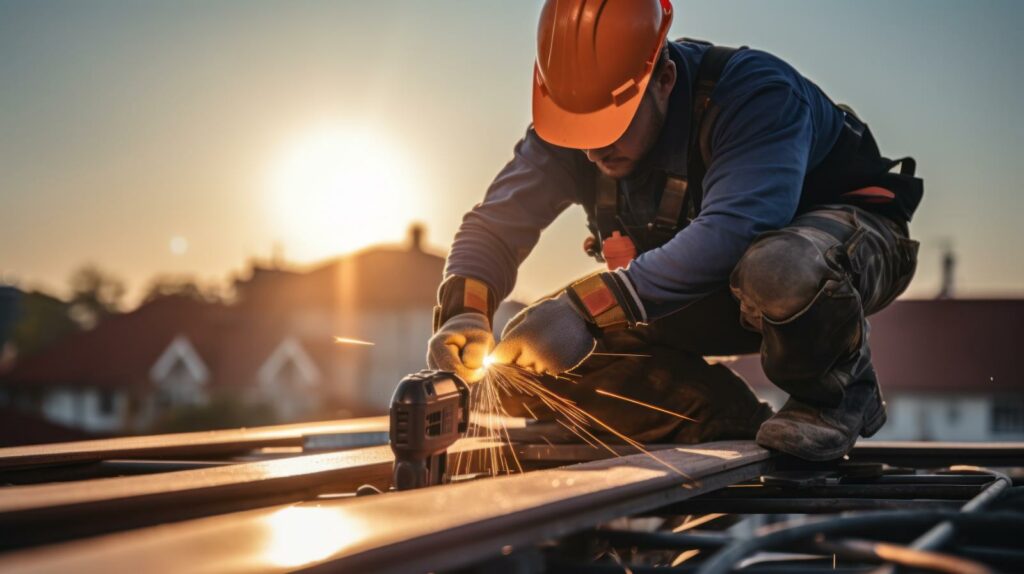
Contents
When it comes to constructing steel structures that can withstand the test of time, the choice of materials and design techniques is paramount. Imagine a steel bridge enduring decades of heavy traffic and harsh weather conditions without showing signs of deterioration. How is this possible? By dissecting the intricacies of steel construction, including the selection of weather-resistant steel grades, innovative design methodologies, and strategic maintenance practices, a roadmap to building resilient structures unfolds. Stay tuned as we unravel the key principles that make steel buildings stand strong against nature’s forces.
Key Takeaways
- Select weather-resistant steel grades for durability.
- Apply protective coatings like galvanized finishes.
- Design structures with effective drainage systems.
- Incorporate redundancy and distribute loads efficiently.
- Implement regular maintenance to prevent corrosion.
Benefits of Weather-Resistant Steel Structures
Embracing weather-resistant steel structures enhances durability and minimizes maintenance costs in harsh environmental conditions. The cost benefits of utilizing weather-resistant steel are substantial. By choosing this material, you’re investing in a long-term solution that requires minimal upkeep, saving you both time and money in the long run.
Weather-resistant steel offers longevity advantages that traditional materials struggle to match. Its corrosion-resistant properties guarantee that your structure remains intact even in the face of challenging weather conditions. This longevity translates to decreased maintenance needs over time, reducing the overall costs associated with upkeep.
When considering the financial aspects, weather-resistant steel structures provide a clear advantage. While the initial investment might be slightly higher than conventional materials, the long-term cost savings make it a smart choice for those looking to minimize expenses over the life cycle of the structure. Additionally, the durability of weather-resistant steel means that you won’t have to worry about frequent repairs or replacements, further adding to the cost benefits of this material.
Choosing the Right Steel Material
When selecting steel materials for your structure, consider factors such as:
Steel grade: The steel grade will determine the strength and durability of your structure.
Corrosion resistance: Factors are essential in ensuring the longevity of the steel material.
Steel Grade Selection
Selecting the appropriate steel grade is crucial to ensure the structural integrity and performance of your steel construction project. When comparing steel grades, consider factors such as material longevity, weatherproofing techniques, and structural strength to secure a durable and weather-resistant structure. Here is a comparison table to aid in your steel grade selection:
| Steel Grade | Material Longevity | Weatherproofing | Structural Strength |
|---|---|---|---|
| Grade A | High | Excellent | Good |
| Grade B | Very High | Good | Excellent |
| Grade C | Moderate | Excellent | Moderate |
| Grade D | Low | Moderate | Low |
Make an informed decision based on your project’s specific requirements and environmental conditions.
Corrosion Resistance Factors
To secure the longevity and durability of your steel structures, it’s imperative to carefully consider the corrosion resistance factors when selecting the appropriate steel material.
Corrosion prevention is essential in maintaining the structural integrity of your steel construction. When choosing a steel material, opt for those with protective metal finishes such as galvanized coatings or stainless steel, as these provide an additional layer of defense against corrosion.
Galvanized coatings create a barrier that shields the steel from corrosive elements, while stainless steel contains chromium, which forms a passive layer that prevents rust formation.
Design Considerations for Durability
When designing steel structures for durability, it is essential to focus on material selection and protective coatings. Consider the environment and potential corrosive elements that could impact the structure over time.
Implementing proper protective measures from the start will guarantee the longevity and integrity of the steel construction.
Material Selection
For excellent durability in steel structure design, thoroughly evaluating material properties is essential. When choosing materials for your steel structure, prioritize heat resistance and structural strength.
Opt for materials that can withstand high temperatures without compromising their integrity. Look for steel grades that offer exceptional heat resistance, ensuring the structure remains stable even in extreme conditions.
Additionally, focus on materials with high structural strength to support the load requirements of the building over its lifespan. By selecting materials with superior heat resistance and structural strength, you lay a solid foundation for a durable and long-lasting steel structure.
Make informed decisions based on these key factors to enhance the overall performance and longevity of your construction project.
Protective Coatings
Evaluate various protective coatings for your steel structure design based on their ability to enhance durability and resistance to environmental factors. When considering protective coatings, factors such as coating application techniques, surface preparation, long-term performance, and cost-effectiveness are essential. Proper surface preparation guarantees the adhesion and longevity of the coating, while different application techniques like spraying, brushing, or dipping can impact the coating’s effectiveness. Long-term performance should be a key consideration, as the coating should withstand weathering, corrosion, and physical damage over time. Additionally, balancing cost-effectiveness with durability is vital for a successful protective coating choice. Refer to the table below for a comparison of common protective coatings used in steel structures.
| Coating Type | Application | Long-Term Performance | Cost-Effectiveness |
|---|---|---|---|
| Epoxy | Spray, Brush | High | Moderate |
| Polyurethane | Spray, Dip | Very High | High |
| Zinc-Rich Primer | Spray | High | Low |
| Galvanized Steel | Dip | Very High | High |
Weatherproof Coatings and Finishes
To ensure peak protection against the elements, selecting suitable weatherproof coatings and finishes is essential in the construction of steel structures. When considering weatherproof coatings, the selection process is vital. Opt for coatings that provide resistance against corrosion, UV radiation, and extreme temperatures. Application techniques play a significant role in the effectiveness of the coating. Proper surface preparation, including cleaning and priming, helps to maximize adhesion and durability.
Long-term performance is a key factor in weatherproof coatings. Evaluate the expected lifespan of the coating in different weather conditions to determine its cost-effectiveness over time. Conduct a thorough cost analysis that includes initial application expenses and future maintenance costs. Investing in high-quality coatings may initially seem more expensive but can lead to significant savings in maintenance and replacement costs in the long run.
When choosing finishes for steel structures, consider not only the aesthetic appeal but also the functionality. Powder coatings, for example, provide a durable finish that’s resistant to chipping, scratching, and fading. Anodizing finishes offer enhanced corrosion protection and can improve the structural longevity of the steel. By selecting weatherproof coatings and finishes wisely, you ensure that your steel structures remain durable, weather-resistant, and visually appealing for years to come.
Structural Engineering for Longevity
Consider structural engineering principles that prioritize longevity when designing steel structures to ensure their durability over an extended period. Longevity strategies play an important role in guaranteeing the durability of steel structures. To achieve this, structural design techniques such as proper material selection, efficient load distribution, and robust connection details are essential.
When it comes to longevity strategies, selecting high-quality materials is paramount. Using corrosion-resistant steel and coatings can greatly extend the lifespan of the structure. Additionally, implementing effective drainage systems and designing structures to minimize water accumulation can prevent corrosion and deterioration over time.
Structural design techniques like incorporating redundancy in critical elements can enhance the overall durability of steel structures. By distributing loads efficiently and avoiding stress concentrations through proper detailing, you can improve the structure’s resistance to fatigue and other forms of degradation.
Furthermore, employing advanced modeling and simulation tools during the design phase can help identify potential weak points and optimize the structural integrity of the steel building. By integrating these tools into the design process, you can ensure that the structure meets longevity requirements and remains durable in the face of various external factors.
Maintenance Tips for Steel Buildings
Implementing a regular maintenance schedule is essential for preserving the structural integrity and longevity of steel buildings. To guarantee your steel structure remains in top condition, focus on two key aspects: rust prevention and surface maintenance.
Rust prevention is critical for maintaining the durability of steel buildings. Inspect your structure regularly for any signs of rust or corrosion. Address any areas where the paint has chipped or scratched, as these are vulnerable points for rust to develop. Applying a high-quality rust-inhibiting paint or coating can provide an additional layer of protection against corrosion. Consider scheduling routine inspections by professionals to catch any rust early on.
Surface maintenance is another crucial aspect of caring for steel buildings. Clean the surface of your structure regularly to remove dirt, grime, and other contaminants that can degrade the protective coating. Use mild detergents and water to wash the surface, avoiding harsh chemicals that can damage the steel. Inspect the coating for any signs of wear and tear, and touch up any areas where the coating has been compromised to prevent moisture and rust from penetrating the steel.
Resilience Against Harsh Weather Conditions
Maintaining steel structures to withstand harsh weather conditions requires diligent attention to protective coatings and structural reinforcements. In areas with extreme climates, such as frequent heavy rain, snow, or high winds, the structural integrity of steel buildings can be compromised without proper measures in place.
To ensure resilience against harsh weather conditions, it’s important to apply high-quality protective coatings to the steel surfaces. These coatings act as a barrier against moisture, preventing corrosion and rust that can weaken the structure over time. Regular inspections and maintenance of these coatings are essential to affirm their effectiveness in extreme climates.
Additionally, structural reinforcements play an essential role in enhancing the durability of steel buildings. Features like bracings, trusses, and welded connections can help distribute the load more effectively during severe weather events, reducing the risk of structural damage. Proper design and implementation of these reinforcements are imperative for ensuring the overall stability and strength of the building.
Sustainability Features in Metal Buildings
To enhance the sustainability of metal buildings, incorporating energy-efficient systems and materials is essential. Green building practices focus on reducing environmental impact and maximizing efficiency. In metal buildings, sustainable design involves utilizing materials with high-recycled content, such as steel that can be recycled repeatedly without losing quality. This not only conserves natural resources but also reduces energy consumption during manufacturing processes.
Another key aspect of sustainable design in metal buildings is the integration of energy-efficient systems. This includes installing insulation with high R-values to minimize heat loss or gain, thereby reducing the energy needed for heating and cooling. Additionally, incorporating daylighting strategies through skylights or large windows can reduce the reliance on artificial lighting during the day, further enhancing energy efficiency.
Water conservation is also an important component of green building practices. Implementing rainwater harvesting systems can help collect and store rainwater for non-potable uses like irrigation or flushing toilets. This reduces the demand on municipal water sources and promotes sustainable water management within the building.
Enhancing Durability Through Proper Installation
Proper installation techniques play an essential role in enhancing the durability of steel structures. When it comes to long-term durability, the manner in which steel components are installed can greatly impact their performance over time. One important aspect of proper installation is ensuring that all connections are secure and correctly fastened. Utilizing high-quality fasteners that are suitable for the specific application can prevent issues such as corrosion and loosening of connections, which can compromise the structural integrity of the building.
Additionally, following manufacturer guidelines and industry best practices during installation is necessary for maximizing the lifespan of steel structures. This includes correctly aligning and positioning components, as well as properly anchoring the structure to its foundation to ensure stability and resistance to external forces. Adequate bracing and reinforcement should also be implemented to distribute loads effectively and prevent excessive stress on individual components.
Furthermore, employing skilled and experienced professionals for the installation process is crucial. Proper training and knowledge of steel construction techniques can help avoid common mistakes that may lead to premature deterioration of the structure. By investing in quality installation practices, you can significantly enhance the durability and longevity of your steel building, ensuring its resilience against environmental factors and structural challenges for years to come.
Review
You’ve learned the key elements to building durable and weather-resistant steel structures, but you may be wondering about the upfront costs.
While initial investment may be higher, the long-term benefits far outweigh any immediate expenses.
By prioritizing durability, weatherproofing, and sustainability, you can ensure your steel structure stands the test of time and ultimately saves you money in maintenance and repairs.
Invest wisely in your steel building for lasting strength and resilience.
Recent Posts
What Are Affordable Metal Garage Options for Farms?
Imagine you’re managing a bustling farm like Smith’s Acres, where every inch of space counts.
What Are Your Options for Agricultural Metal Storage?
When you’re exploring agricultural metal storage options, it’s crucial to take into account the various
How to Choose Versatile Agricultural Metal Structures
When you’re considering versatile agricultural metal structures, it’s essential to start by evaluating your specific




